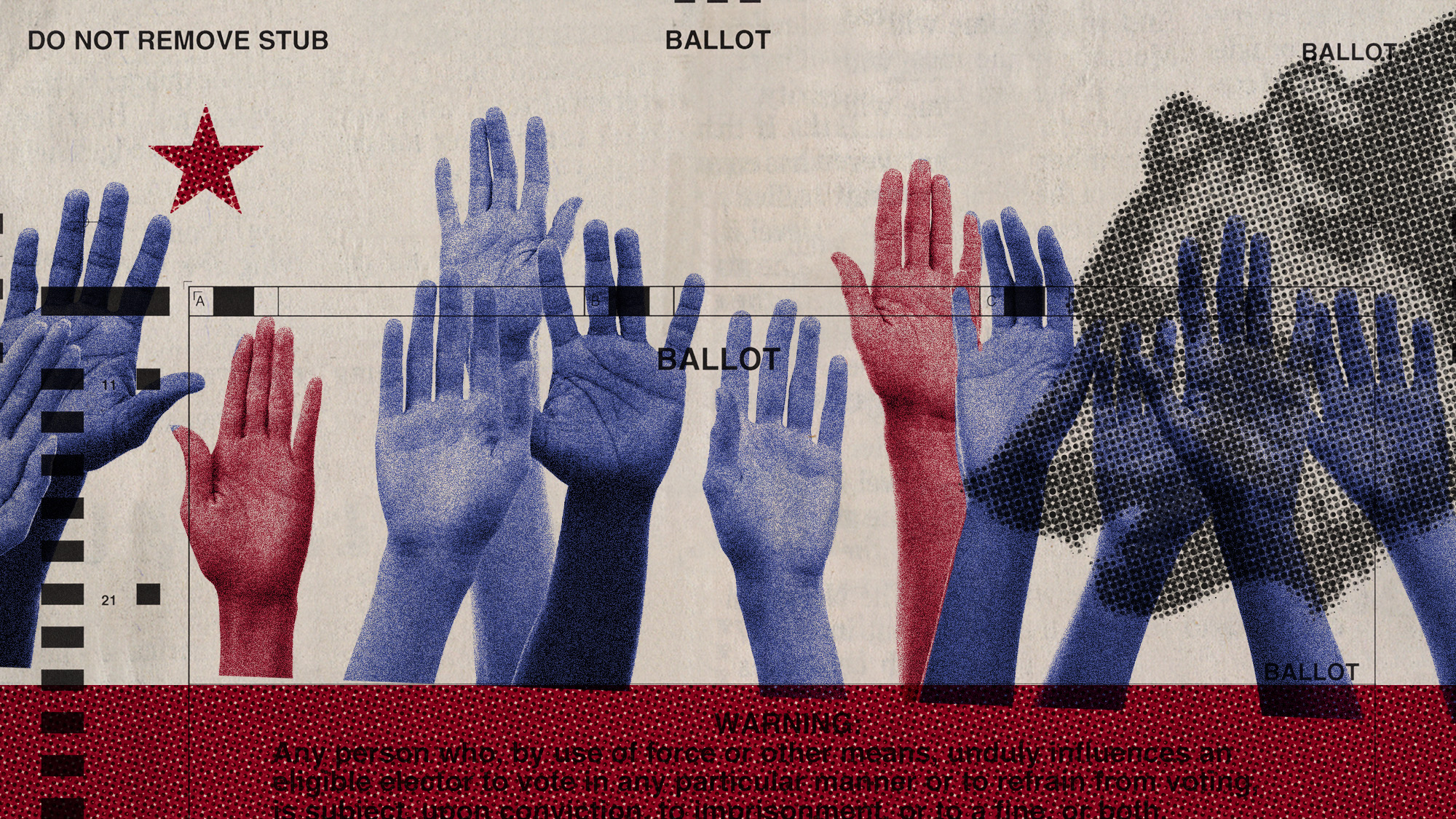Drawing lines for power
Democrats and Republicans spent months fighting over new congressional districts — and ended up with a draw.

Democrats and Republicans spent months fighting over new congressional districts — and ended up with a draw. Here's everything you need to know:
What was the fight about?
Control of Congress after the 2022 midterm elections. The Constitution decrees that, after each 10-year census, state legislatures can use the results to redraw congressional districts. After the 2020 census, that opportunity ignited fierce partisan battles in many states, with both parties seeking to ensure they'd win as many seats as possible. The principal tool was gerrymandering — using past voting data and sophisticated algorithms to create district boundaries that zig and zag, sometimes to an absurd degree, to include some voters and exclude others. The GOP historically does this more effectively, but Democrats made a concerted effort this year to match them. Of states receiving an "F" grade from the Princeton Gerrymandering Project for highly partisan redistricting, four are controlled by Democrats (New York, Maryland, Illinois, Oregon) and three by the GOP (Texas, North Carolina, Ohio). Democrats have also won some key legal challenges to Republican redistricting. "We're doing a hell of a lot better than pundits thought we would," said Democratic Congressional Campaign Committee Chair Rep. Sean Patrick Maloney of New York.
The Week
Escape your echo chamber. Get the facts behind the news, plus analysis from multiple perspectives.

Sign up for The Week's Free Newsletters
From our morning news briefing to a weekly Good News Newsletter, get the best of The Week delivered directly to your inbox.
From our morning news briefing to a weekly Good News Newsletter, get the best of The Week delivered directly to your inbox.
In what states did Democrats gain an advantage?
In New York, California, Maryland, and Illinois, Democrats used their legislative majorities to redraw districts to enhance their chances of gaining seats in 2022. In New York, voting trends suggest Republicans should hold nine or 10 of the state's 26 seats. The map Albany Democrats drew leaves Republicans likely to win just four, with one district in conservative-leaning Staten Island up for grabs because it now includes a populous part of ultra-liberal Brooklyn. Donald Trump won 41 percent of Illinois' 2020 vote, but the state's new map all but locks Democrats into 13 of 17 seats. Maryland Republicans might not muster a single win. And in the 11 states that delegate redistricting to nonpartisan committees, maps broke mostly in Democrats' favor, especially in California. So far, redistricting has created 11 more districts nationally that lean Democrat.
Where did the GOP succeed?
Most notably in Texas, Tennessee, and Georgia. In Tennessee, Nashville has been represented by a single House seat held by Democrats for 147 years. This year, Tennessee Republicans split the district into three parts and moved them into the surrounding, deep-red rural districts, meaning that heavily Democratic Nashville will almost certainly have GOP representation going forward. In many other GOP-controlled states, however, court rulings or constitutional amendments limited Republicans' ability to gerrymander. Courts in Florida, Pennsylvania, Ohio, and Virginia rejected GOP efforts to skew maps. In North Carolina, the state Supreme Court threw out a map that would have given Republicans control of 10 out of 14 House seats, despite voters being roughly evenly divided between the parties. Instead, the court let a nonpartisan expert panel draw a balanced map — a ruling that the U.S. Supreme Court let stand.
A free daily email with the biggest news stories of the day – and the best features from TheWeek.com
So gerrymandering is legal?
It's complicated. In a pivotal case in 2019, the Supreme Court ruled 5-4 along partisan lines that gerrymandering is a "political question" that is not reviewable by federal courts. In the majority opinion, Chief Justice John Roberts conceded that extreme redistricting can lead to results that "reasonably seem unjust." But he said that if voters don't like the districts created by their state legislators, they can vote them out. The court has made one exception, saying that gerrymandering for racial reasons is unconstitutional. The distinction between partisan and racial motives, however, can be slippery. Last month, the Supreme Court let stand an Alabama congressional map that includes only one majority-Black district out of seven, even though Black voters make up 25 percent of the state's population. The five Supreme Court conservative justices ruled it was too late in the election cycle to intervene.
Will the midterms be competitive?
Control of the House is still up for grabs, but legislatures drew districts to shield incumbents from serious challengers. So only about 40 seats out of 435 are considered competitive, according to an analysis by The New York Times, down from 73 a decade ago. Political scientists say reduced competition between parties will exacerbate political polarization and gridlock.
How so?
Traditionally, general elections inspire candidates to move toward the ideological center in an effort to attract swing voters. But when incumbents don't have to worry about losing to the opposition party, they often move further left or right to fend off primary challengers. Nearly 90 percent of the next House could be made up of lawmakers who face little threat of losing a general election. No state has eliminated competition more aggressively than Texas. In 2020, 12 districts were competitive. After redistricting, just one race out of 38 looks to be close. As a result, Republican Rep. Dan Crenshaw says, the real battles now occur within parties. "Does this create incentives to avoid governing?" he said. "Clearly."
An explosive legal theory
For now, state courts are the strongest check on extreme gerrymandering. But that check may soon be removed by the Supreme Court, under a provocative theory called the independent state legislature doctrine. This doctrine, which conservative legal theorists have been promoting for decades, argues that the Constitution gives absolute power to state legislatures to draw congressional maps however they like. Under this theory, neither state nor federal courts have any authority to reject extremely skewed maps. North Carolina judges recently rejected that argument, saying it "would produce absurd and dangerous consequences." The Supreme Court let that North Carolina ruling stand — for now — but conservative justices Clarence Thomas, Neil Gorsuch, Samuel Alito, and Brett Kavanaugh indicated openness to revisiting the matter after this year's elections. "State courts do not have a blank check to rewrite state election laws for federal elections," Kavanaugh wrote. Chief Justice John Roberts has indicated he may side with the court's three liberals in favor of letting state (but not federal) courts continue to oversee redistricting. So when the court considers its next gerrymandering case, the deciding vote may be cast by Trump appointee Amy Coney Barrett.
This article was first published in the latest issue of The Week magazine. If you want to read more like it, you can try six risk-free issues of the magazine here.
-
 Wake Up Dead Man: ‘arch and witty’ Knives Out sequel
Wake Up Dead Man: ‘arch and witty’ Knives Out sequelThe Week Recommends Daniel Craig returns for the ‘excellent’ third instalment of the murder mystery film series
-
 Zootropolis 2: a ‘perky and amusing’ movie
Zootropolis 2: a ‘perky and amusing’ movieThe Week Recommends The talking animals return in a family-friendly sequel
-
 The twists and turns in the fight against HIV
The twists and turns in the fight against HIVThe Explainer Scientific advances offer hopes of a cure but ‘devastating’ foreign aid cuts leave countries battling Aids without funds
-
 GOP wins tight House race in red Tennessee district
GOP wins tight House race in red Tennessee districtSpeed Read Republicans maintained their advantage in the House
-
 Looming drone ban has farmers and farm-state Republicans anxious
Looming drone ban has farmers and farm-state Republicans anxiousIN THE SPOTLIGHT As congressional China-hawks work to limit commercial drone sales from Beijing, a growing number of conservative lawmakers are sounding an agricultural alarm
-
 US government shutdown: why the Democrats ‘caved’
US government shutdown: why the Democrats ‘caved’In the Spotlight The recent stalemate in Congress could soon be ‘overshadowed by more enduring public perceptions’
-
 A crowded field of Democrats is filling up the California governor’s race
A crowded field of Democrats is filling up the California governor’s raceIn the Spotlight Over a dozen Democrats have declared their candidacy
-
 Will Chuck Schumer keep his job?
Will Chuck Schumer keep his job?Today's Big Question Democrats are discontented and pointing a finger at the Senate leader
-
 GOP retreats from shutdown deal payout provision
GOP retreats from shutdown deal payout provisionSpeed Read Senators are distancing themselves from a controversial provision in the new government funding package
-
 Is Trump a lame duck president?
Is Trump a lame duck president?Talking Points Republicans are considering a post-Trump future
-
 Democrats split as Senate votes to end shutdown
Democrats split as Senate votes to end shutdownSpeed Read The proposed deal does not extend Affordable Care Act subsidies, the Democrats’ main demand